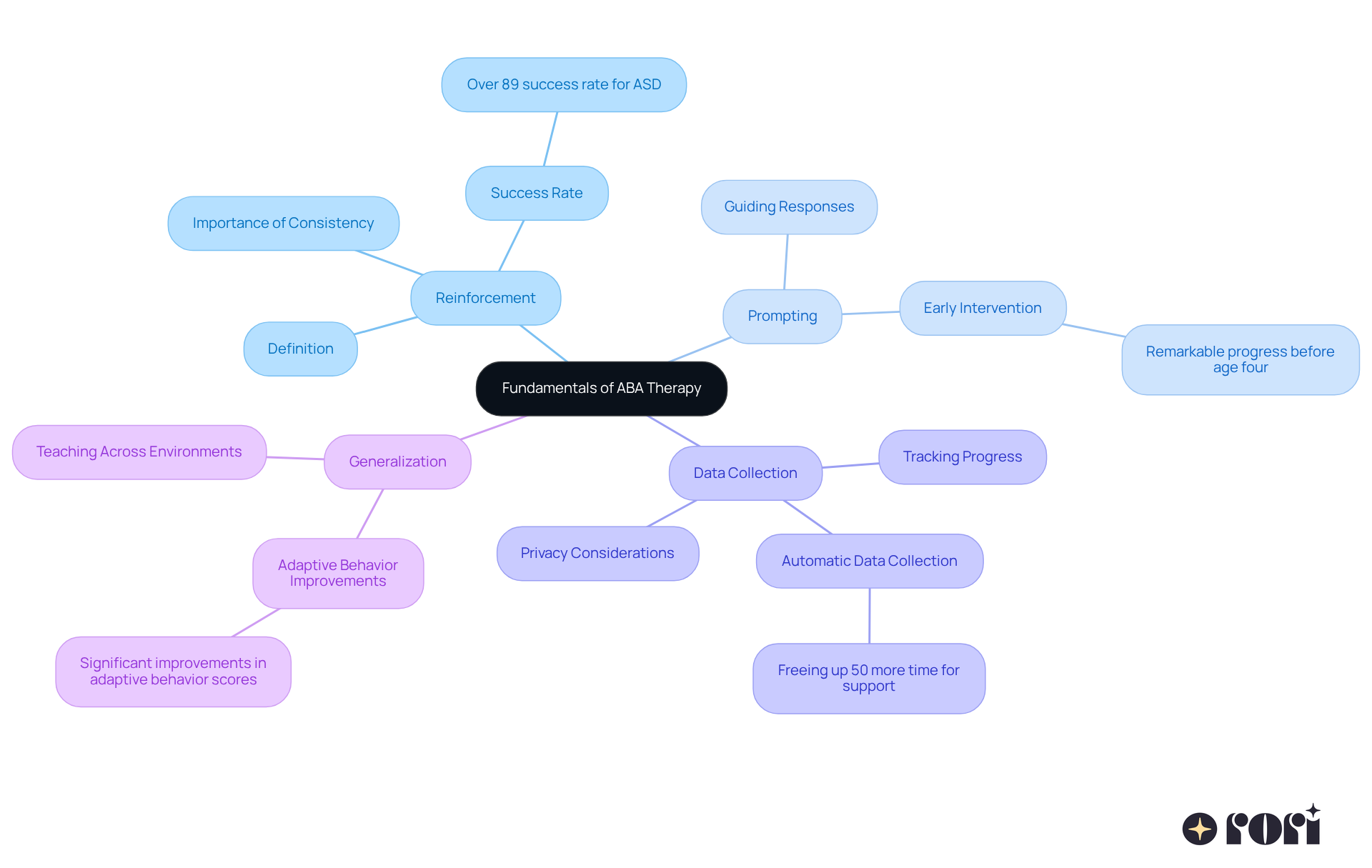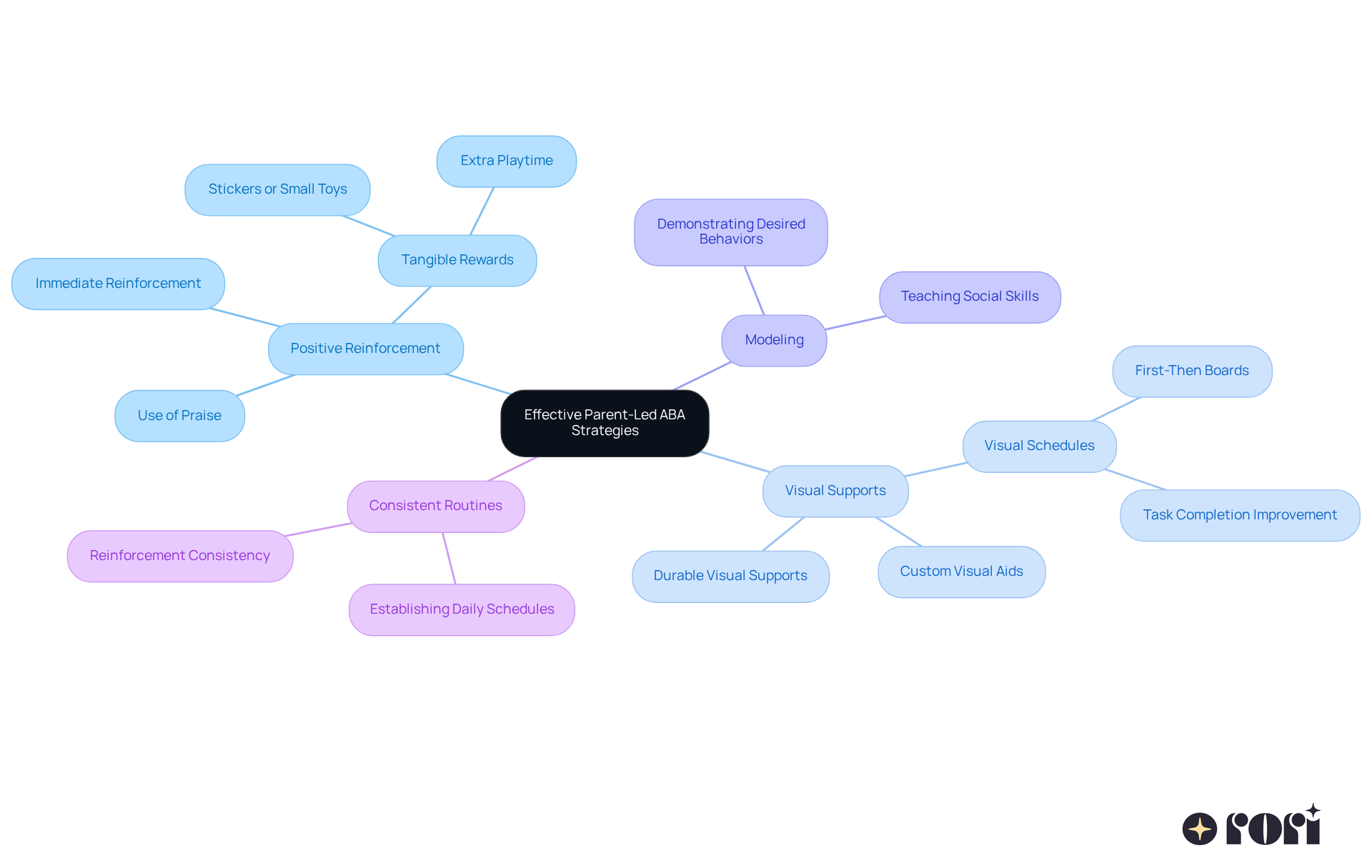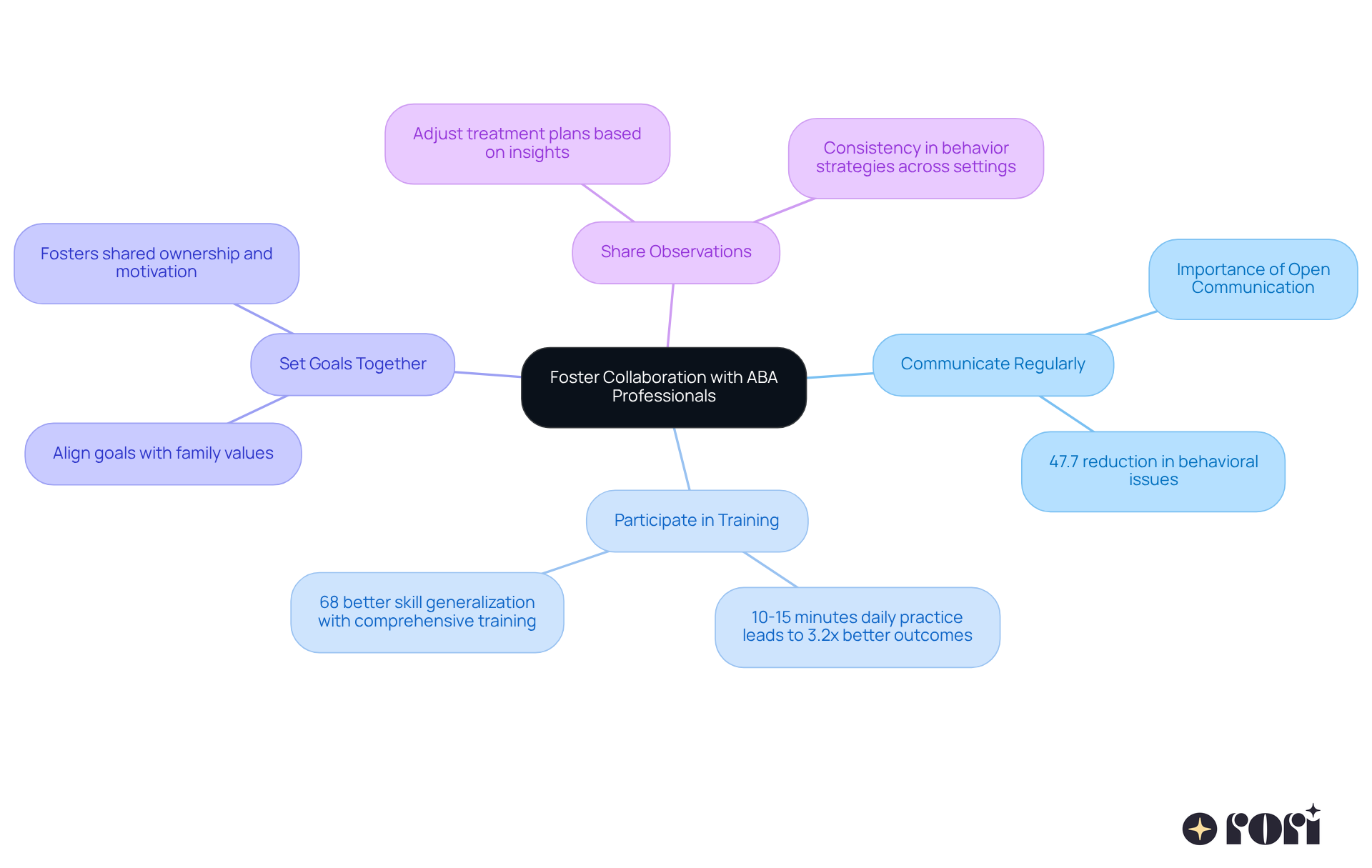Understanding the nuances of Applied Behavior Analysis (ABA) therapy is so important for parents who want to support their children with autism effectively. By getting a handle on key strategies like reinforcement, prompting, and data collection, parents can truly make a difference in their child’s therapeutic journey. But here’s the thing: how can parents turn this knowledge into real, actionable support that boosts their child’s learning and development?
What specific strategies can parents implement to maximize the benefits of ABA therapy and build a collaborative relationship with professionals? Let’s explore this together! We’re here to help you every step of the way!
Applied Behavior Analysis (ABA) is a scientific method that focuses on understanding and improving specific behaviors in individuals with autism. Let’s break down some foundational principles of ABA that can really make a difference:
Reinforcement: Think of this as a way to celebrate successes! When a desired behavior is followed by a reward, it encourages that behavior to happen again. Research shows that consistent reinforcement can lead to significant behavioral improvements, with ABA interventions boasting a success rate of over 89% for individuals with ASD. Isn’t that encouraging?
Prompting: This technique is all about guiding kids toward the right response or behavior with helpful cues or hints. Many specialists emphasize that early and intensive intervention is key. In fact, studies reveal that kids who start treatment before age four often show remarkable progress. It’s like giving them a little nudge in the right direction!
Data Collection: Keeping track of progress is super important in ABA therapy. At Rori Care, we use automatic data collection techniques, which means our clinical team can focus entirely on your child without interruptions for note-taking. This not only secures the data but also ensures privacy, as we anonymize and delete information after analysis. By understanding how a child responds, therapists can adjust strategies to keep interventions effective and tailored to individual needs. This data-driven approach can actually free up 50% more time for supporting youth!
Generalization: Teaching skills across different environments is crucial. It helps ensure that kids can use what they’ve learned in various situations. Research shows that children who engage in ABA treatments early often see significant improvements in their adaptive behavior scores. It’s all about making those skills stick!
By familiarizing yourself with these core concepts, you can better understand the strategies that are designed for empowering parents in ABA therapy, which your child will encounter in treatment. This knowledge plays a key role in empowering parents in ABA therapy to support their progress effectively. Plus, being aware of the costs and challenges families face in accessing ABA support can give you a clearer picture of the landscape surrounding these essential services.
Let’s explore this journey together! We’re here to help you every step of the way!

The involvement of parents is crucial in the ABA process, and empowering parents in ABA therapy can make a world of difference for their kids. Let’s dive into some key areas where parents can shine:
The impact of empowering parents in ABA therapy is truly profound. Studies show that when parents are more engaged, their kids experience lower stress levels and better outcomes. For instance, empowering parents in ABA therapy allows children to reach their goals faster because they can practice skills in real-life situations. By recognizing their role as change-makers, parents can create an environment that focuses on empowering parents in ABA therapy, allowing their children to thrive and achieve lasting behavioral improvements and a better quality of life.
Plus, through caregiver education, parents gain a deeper understanding of ABA principles and strategies. This knowledge empowers them to make informed decisions that positively affect their child’s progress. So, let’s explore this journey together! We’re here to help you every step of the way!

Effective parent-led ABA strategies can really boost a young person's learning experience! Here are some key approaches to consider:
Positive Reinforcement: Think about using praise or small rewards to encourage those desired behaviors. For example, when your kid completes a task, celebrate their success with some verbal praise or maybe even a sticker! Research shows that immediate reinforcement after a desired behavior strengthens the connection between the behavior and the reward, making it more likely to happen again. This method not only teaches specific skills but also creates a supportive learning environment.
Visual Supports: Have you tried using visual schedules or charts? They can really help your little one understand daily routines and what’s expected of them. Visual supports, like first-then boards, can lead to a 25% improvement in task completion rates! They provide clear, structured cues that boost independence and ease anxiety around transitions. Studies show that using visual schedules can significantly reduce resistance to change, making them a must-have tool in ABA therapy.
Modeling: Another great strategy is to demonstrate the behaviors you want your child to imitate. For instance, if you want them to greet others, show them how it’s done first! This technique is super effective in teaching social skills, as kids learn to repeat desirable actions through positive reinforcement.
Consistent Routines: Establishing a regular daily schedule can help kids feel secure and understand what’s coming next. It’s really important to be consistent with reinforcement strategies across different settings. This way, you avoid confusion and help your child generalize the skills they’ve learned during therapy.
By weaving these strategies into your everyday life, you can really strengthen the skills your child has picked up in therapy, thereby empowering parents in ABA therapy and encouraging generalization. This ultimately leads to improved development and independence for your little one. Let’s explore this together!

To foster effective collaboration with ABA professionals, parents should:
Communicate Regularly: Keeping those lines of communication open with therapists is so important! It’s all about discussing progress, challenges, and strategies together. Did you know that empowering parents in ABA therapy can lead to a whopping 47.7% reduction in behavioral issues for caregivers who actively participate in their child's program compared to those who don’t? That’s a big difference!
Participate in Training: Joining training sessions at Rori Care can really equip caregivers with handy techniques to use at home. Research shows that caregivers who spend just 10-15 minutes a day practicing skills between sessions achieve results 3.2 times better than those who don’t practice consistently. Plus, parents whose kids received comprehensive ABA training showed 68% better skill generalization than those in traditional therapist-only programs. This training is dedicated to empowering parents in ABA therapy by helping caregivers understand ABA principles better, which allows them to make informed decisions that positively impact their child’s progress.
Set Goals Together: Collaborating with therapists to set clear, achievable goals is key! It ensures that everyone is on the same page and that empowering parents in ABA therapy aligns the goals with the family’s values and the child’s needs. This joint effort fosters a sense of shared ownership and motivation, making the whole therapeutic experience even better.
Share Observations: Sharing insights about your child’s behavior at home can really help therapists adjust treatment plans. When parents actively share their observations, it plays a crucial role in empowering parents in ABA therapy to achieve a more tailored approach, which can improve outcomes. As Yitz Dien wisely notes, "The active involvement of guardians fosters consistency in behavior strategies across various settings-home, school, and community-thereby assisting in the generalization of skills."
Engaging actively with ABA professionals at Rori Care is a way of empowering parents in ABA therapy to ensure that their child’s therapy is customized to meet their unique needs and circumstances. This not only enhances the effectiveness of the intervention but also makes a difference in the overall experience. Plus, parent-mediated interventions can cut treatment costs by up to 33% while still achieving comparable outcomes. So, parental involvement is not just beneficial for the child; it’s also a smart financial choice!
Let’s explore this together! We’re here to help you every step of the way!

Empowering parents in ABA therapy is so important for helping children with autism make real progress. When parents grasp the basics of Applied Behavior Analysis and get involved in their child's therapy, they can really boost the effectiveness of the interventions. This teamwork not only helps the child but also builds a nurturing environment that encourages learning and growth.
In this article, we’ve shared some key strategies that parents can use to support their child's ABA therapy effectively:
Plus, using parent-led strategies like positive reinforcement, visual supports, and consistent routines can really help reinforce learning and assist children in applying their skills in different settings.
Ultimately, empowering parents in ABA therapy is a shared journey that thrives on open communication and collaboration with ABA professionals. By engaging in training, setting goals together, and sharing observations, parents can make sure their child's therapy is tailored to their specific needs. This not only leads to better outcomes for the child but also helps parents feel more confident and involved. Embracing these strategies and actively participating in the therapeutic process can create lasting positive change, making a real difference in the lives of children and their families. Let’s explore this together!
What is Applied Behavior Analysis (ABA) therapy?
ABA therapy is a scientific method that focuses on understanding and improving specific behaviors in individuals with autism.
What is reinforcement in ABA therapy?
Reinforcement is a technique used to encourage desired behaviors by following them with a reward. Consistent reinforcement can lead to significant behavioral improvements, with ABA interventions showing a success rate of over 89% for individuals with Autism Spectrum Disorder (ASD).
How does prompting work in ABA therapy?
Prompting involves guiding children toward the right response or behavior using helpful cues or hints. Early and intensive intervention is emphasized, with studies showing that children who start treatment before age four often make remarkable progress.
Why is data collection important in ABA therapy?
Data collection is crucial for tracking progress in ABA therapy. It allows therapists to adjust strategies based on how a child responds, ensuring interventions are effective and tailored to individual needs. At Rori Care, automatic data collection techniques are used to maximize focus on the child and maintain privacy.
What is generalization in the context of ABA therapy?
Generalization refers to teaching skills across different environments to ensure that children can apply what they've learned in various situations. Research indicates that children who engage in ABA treatments early often see significant improvements in their adaptive behavior scores.
How can understanding these core concepts help parents?
Familiarizing themselves with the core concepts of ABA therapy empowers parents to better support their child's progress and navigate the challenges and costs associated with accessing ABA services.